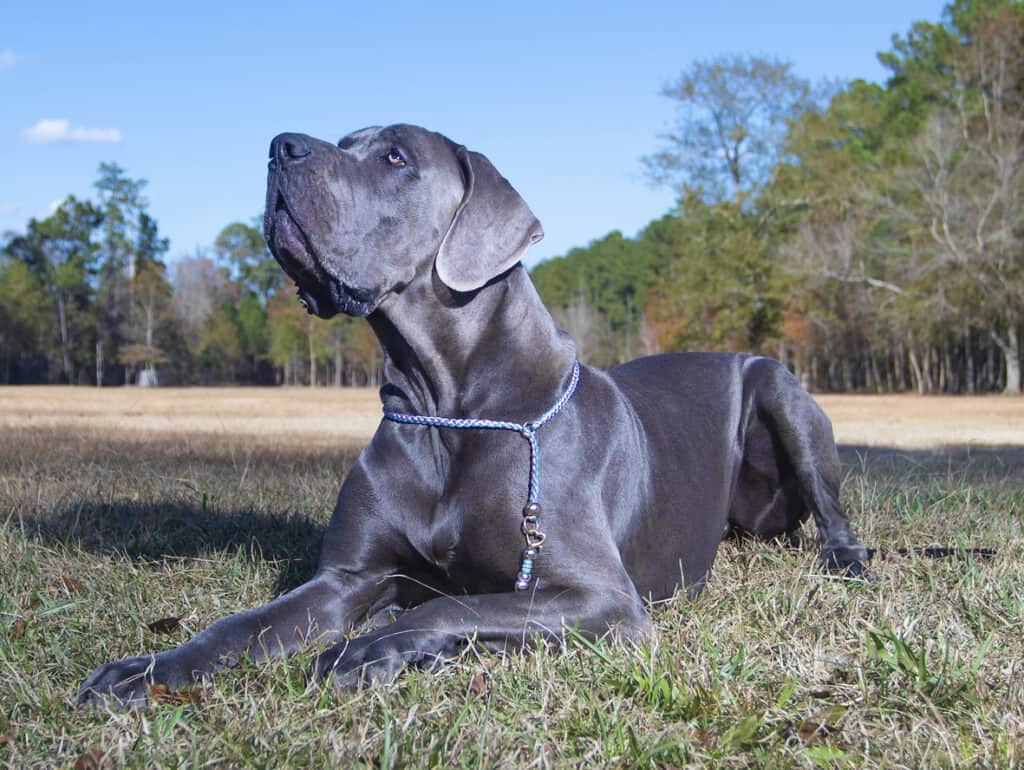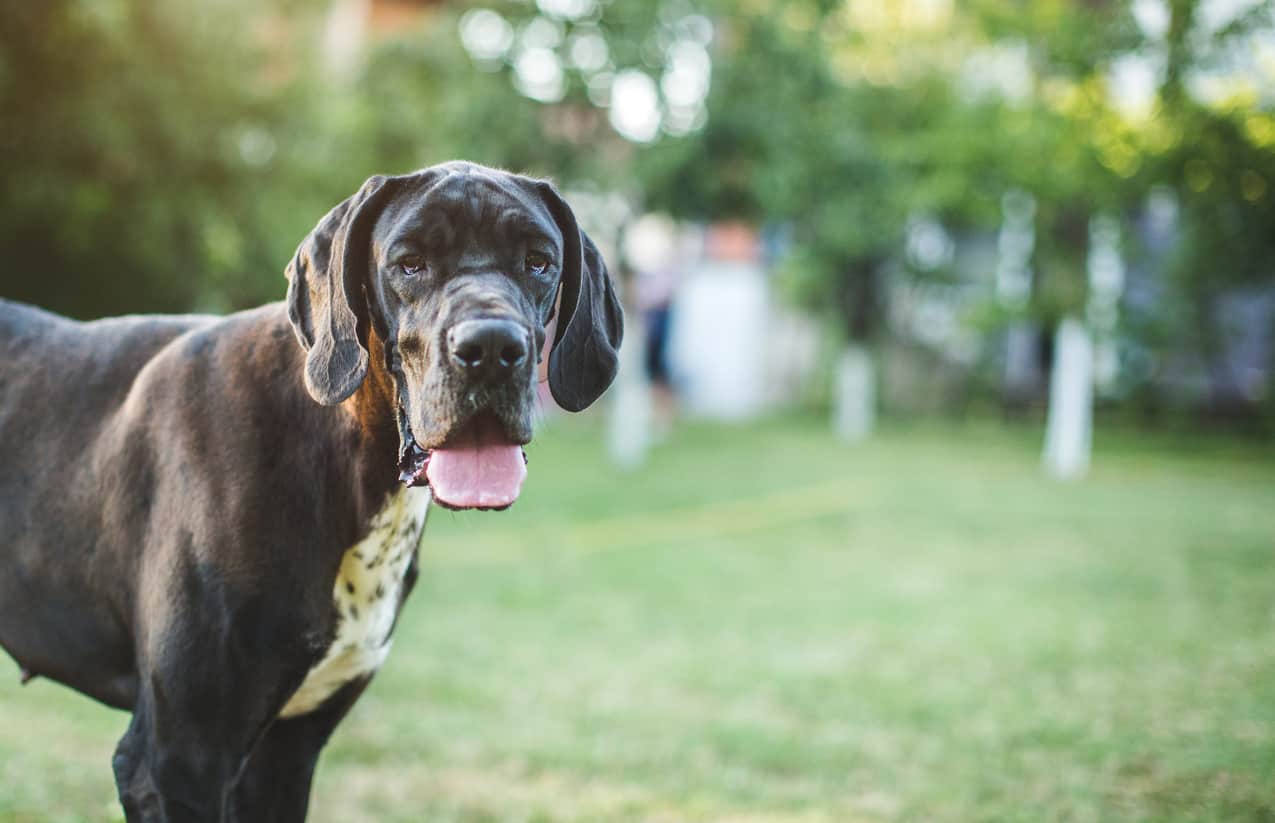If you’ve ever seen a Great Dane, you may have wondered how old it was. These massive dogs always make a scene when they’re out and about with their owners and a frequent question that emerges in talks with owners tends to be, “When do Great Danes stop growing?”

In general, Great Danes have 3 phases: puppyhood, adolescence, and adult. The puppyhood phase lasts 3 months, the adolescence stage lasts from month 3 up to month 16, and adulthood is anything past 16 months. Great Danes usually stop growing in adulthood, which is around 12-16 months.
The answer to this question is not as straightforward as you might think. In addition to having a prolonged growth period as a puppy, Great Danes also take extra time to full fill out and pack on muscle. This prolonged growth period is due to the fact that Great Dane puppies simply have so much growing to do – there just isn’t enough time for it to reach its full size within the first six or eight months of its life like other smaller breeds.
Great Dane growth is typically broken down into three phases: puppyhood, adolescence, and adult. These phases can be roughly blocked out, but can vary from Dane to Dane. For example, the holder of the World’s Tallest Dog title from 2016-2021 was a massive sweetheart of a Great Dane named Freddy. What does this have to do with how Great Danes grow? Well, Freddy’s owner, Claire, revealed in an interview that when she originally brought him home, Freddy was the runt of the litter! When all his puppy chow was finished though and Freddy emerged from the infamous Great Dane growth spurt, he stood 40 inches (103.5 cm) tall at the shoulder. While Freddy was an unusually large Great Dane, his growth pattern still generally followed the trends described below.
Phases of Great Dane Growth
| Age | Height |
| 1 Week | — |
| 3 Weeks | — |
| 1 Month | — |
| 6 Weeks | — |
| 2 Months | 13-18 inches |
| 3 Months | 17-23 inches |
| 4 Months | 20-25 inches |
| 5 Months | 24-30 inches |
| 6 Months | 26-33 inches |
| 7 Months | 27-34 inches |
| 8 Months | 28-34 inches |
| 9 Months | 28-35 inches |
| 1 Year Old | 29-36 inches |
Puppyhood

As you can see from the above chart, Great Dane puppies experience a massive growth spurt in their first year of life. Indeed, it’s not unusual for a Great Dane puppy to reach its full (or nearly full) adult height by its first birthday. However, full height does not mean fully developed. After your puppy goes through its growth spurt, its body will turn its attention to filling out and really packing on weight.
When you bring your Great Dane puppy home for the first time, they will likely be about eight weeks old. Within the first one to four months of being in their home, so somewhere between 3-6 months of age, they will likely enter that “growth spurt” phase of their lives and begin to seemingly grow by the hour. Although Great Danes are at their most energetic and playful as puppies, there may be times throughout their growth spurt when they may remind you more of lethargic and perpetually hungry teenage boys – but fortunately, Great Danes are not naturally grumpy like teenage boys!
Prior to bringing home your Great Dane puppy, it’s important to have a feeding plan and tracker in place so that you can carefully monitor your puppy’s progress throughout their prolonged growth period. The reason this is important is because many of the illnesses that Great Danes are predisposed to as a breed can be influenced by the quality of their growth period within that first crucial year of life.
Great Dane weight chart
| Age | Weight |
| Birth Weight | 1-2 lbs |
| 1 Week | 2-3 lbs |
| 3 Weeks | 4-7 lbs |
| 1 Month | 5-8 lbs |
| 6 Weeks | 10-20 lbs |
| 2 Months | 15-30 lbs |
| 3 Months | 25-45 lbs |
| 4 Months | 45-65 lbs |
| 5 Months | 60-85 lbs |
| 6 Months | 65-100 lbs |
| 7 Months | 70-110 lbs |
| 8 Months | 80-120 lbs |
| 9 Months | 85-125 lbs |
| 1 Year Old | 95-140 lbs |
Tracking your Great Dane puppy’s food intake also makes it easier to identify when they have truly started their growth spurt. Of course, you will likely first notice that they seem to be getting big right before your eyes. For the purposes of tracking important information about your Great Dane puppy such as height, it’s a good idea to learn how to properly measure your giant lovebug.

Many people mistakenly think that dogs are measure up to the tallest part of their body, like humans. However, dogs, like horses, are officially measured at a part of the body called the withers. To correctly measure your Great Dane, take a tape measure and start from the bottom of your Dane’s paws. Measure just until the highest peak of the shoulder blades, and then read the tape. Congratulations! You’ve just successfully measured your puppy. Make sure to note the information in a notebook somewhere and to track this data weekly so that you can begin to see your Dane’s growth trajectory.
Of course, it’s not always that easy. Freddy, the former Tallest Dog in the World, was notoriously challenging for the Editor-in-Chief of the Guinness World Records to measure because the strange man and the tape measure made him nervous and skittish. With this in mind, measuring your puppy regularly also serves another function: getting it used to a new object! If you want to be really proactive about socializing (which you should, because Great Danes are a breed that particularly benefit from regular and thorough socialization), you could even invite a family member or a friend over to take the measurement. Additionally, if you plan on showing your Great Dane puppy as an adult, this little extra will prove invaluable in preparing them to be handled by judges in the ring.
As you measure your Great Dane puppy every week and chart its growth, you will also want to note how much food it is or is not consuming, as well as the type of food and its weight. One column should always note the amount of food served, but there should be another for noting if your Great Dane puppy leaves any left over. In the case of leftovers, you should remove the extra food and count it towards the amount reserved for your puppy’s next meal. If your puppy is consistently deviating from the amount of food planned for it, it may be a good idea to consult with your veterinarian to adjust the feeding schedule. Eventually, or if you’re already familiar with raising Great Danes, you will be able to make these adjustments yourself.
When your Great Dane is a puppy, you have lots of options for weighing it. One option is to go the official route and purchase a veterinary scale. While certainly an investment, the price can vary substantially, so there should be something for everyone’s budget. That said, if you’re considering getting a Great Dane and balk at the price of purchasing a veterinary scale, you may want to reconsider whether a Great Dane is the right breed for you because these dogs will cost over $20,000 over the course of their 7–10-year (on average) lifespan.
Another option for weighing a Great Dane puppy is to simply hold it while stepping onto your own scale, then weigh yourself, and subtract the difference. While not an “official” method, if you do this every week, the tracking will be consistent and provide you with the necessary information to ensure that your Great Dane is developing well. The main problem you’ll run into will be being able to comfortable pick up your puppy after about 12 weeks!
Adolescence
Your Great Dane puppy will enter its adolescent period around six months of age. Since this period coincides with their growth spurt, this is also when owners can expect to see any red flags behaviorally. It is also when Great Danes, and all dogs really, can become the most challenging to train. Just like human adolescents, they will revel in their newfound size and sense of importance, and even though they love you and in their hearts want to please you, they may be resistant to following your commands.
Great Danes are generally docile, loving, and affectionate dogs, however, if they are not properly trained and socialized, they can develop some unpleasant quirks. For example, while it may be cute to see a 15-30 pound two-month-old Great Dane puppy rear up onto its hind legs to give you a hug, it will become far less cute if that same puppy as a 45-65 pound four-month-old joyfully charging at you when you walk into the house after an outing. While it’s important to bear in mind that this behavior cannot be tolerated, when it comes to Great Danes, it’s also important to remember that these are highly sensitive dogs.
Danes do not take well to harsh corrections or overcorrections, and owners would do well to remember that getting into a tussle with a still-growing Great Dane is a recipe for problems down the line when they almost inevitably become bigger and stronger than most people.
Although some dog owners may feel a slight despair set in during the “teenage” years (especially because Danes are already so big and still growing during this time), if they are providing consistent and steady obedience classes and taking the time to provide proper socialization for their Great Dane via several walks a day and novel experiences such as trips to the dog park or swimming, their Great Dane will likely turn out fine.
During a Great Dane’s alternatively exuberant and belligerent adolescence, it may occur to you that the time has come to schedule a time to get it sterilized. While this is an excellent long-term health decision, when it comes to Great Danes, the timeline is a little pushed back from the standard six months at which point most puppies are sterilized.
If you intend to sterilize your Great Dane, males should be allowed to reach one year of age intact in order to avoid interfering with the hormones that are influencing their growth period. Females should be allowed to undergo one heat cycle, after which point they will be eligible to be spayed.
Adult
Around eighteen months of age, your Great Dane puppy’s growth will start to noticeably taper off and full maturity will set in around two years of age, though it should be noted that Great Danes may take up to three years to reach their full-size proportions. Up until this point, Great Dane puppies need to be carefully exercised and intense play should be avoided so that their fragile skeletal frame aren’t placed under undo pressure. Around eighteen months is also when hobby runners and joggers can begin introducing their Great Danes to leashed runs. Adult Danes will require 30-60 minutes of exercise total each day, which will keep their silhouette trim and their muscles strong.
A full size male Great Dane will stand at least 30-32 inches at the shoulder, while females hit a minimum of 28-30 inches. Males are typically larger than females, and some have noted that females seem to have a slightly more nurturing instinct with children, although both sexes are considered good family pets. Your Great Dane will weigh anywhere from 100-200 pounds and be a fully sized lapdog if you let it. It will also be a loyal guard dog.


